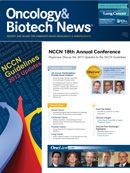Study Seeks to Eliminate Clinical Barriers to Bone Marrow Transplants
Paul V. O'Donnell, MD, PhD, from the Seattle Cancer Care Alliance, discusses a study examining alternative donor transplant methods for patients with hematologic malignancies.
Paul V. O’Donnell, MD, PhD
Seattle Cancer Care Alliance
Researchers have developed two main “alternative donor transplants” for patients with hematologic malignancies who need a bone marrow transplant (BMT) but lack a human leukocyte antigen (HLA) match. One approach uses umbilical cord blood from an unrelated source and the other employs HLA-mismatched (haploidentical) marrow from parents, children, or siblings.
Small phase II trials indicated that these two different approaches can produce survival outcomes that are very similar to each other and to standard approaches with HLA-matched donors.
Vital Questions—Especially for Minorities
But will those results hold up in a larger multicenter randomized trial? Is one approach to alternative donor transplants better than the other? This is the central question now being asked in a major NIH-sponsored study of cord blood transplantation and haploidentical related BMT in patients with hematologic malignancies. Transplant outcomes are strongly affected by the degree of HLA match. The HLA-identical sibling match is still the preferred route for any BMT. Today, many patients who need a BMT but lack a matched sibling donor can find a matched unrelated donor in a marrow registry. Nationally, success rates with matched unrelated donors have improved steadily, from an average overall 1-year survival of 42% in 2003, to 58% in 2010, according to the National Marrow Donor Program. Outcomes at Seattle Cancer Care Alliance (SCCA) are even better than those nationally.
Study Details and Eligibility
However, searching for a match typically takes about 3 months—time that a patient with leukemia or lymphoma often cannot spare. Many patients succumb to their disease during this waiting period. In others, outcomes may be jeopardized by the long wait. And for minorities such as African Americans and Asians, and especially for those of mixed ethnic heritage, the chance of ever finding a suitable HLA-matched donor is very low—on the order of about 20%. SCCA joins about 40 centers nationwide that are participating in this new phase III randomized trial. Paul V. O’Donnell, MD, PhD, is one of the three principal investigators for this study.
Patients between 18 and 70 years of age with acute leukemia or lymphoma will be eligible for enrollment. Only patients lacking an 8/8 HLAmatched donor (sibling or unrelated) will be considered. An exception to this matching criterion may be made in cases of clinical urgency for transplantation. Organ function must be adequate and Karnofsky performance score must be ≥70. Each patient must also have available two partially HLA-matched cord blood units and a partially HLA-mismatched related donor.
After randomization to either double-dose cord blood transplant or haploidentical BMT, patients will receive the appropriate reduced-intensity conditioning regimen, undergo transplantation, and be followed for 3 years. The nonmyeloablative conditioning, which was pioneered at Fred Hutchinson Cancer Research Center (FHCRC), improves engraftment, reduces the risk of graftversus- host disease (GVHD), and helps older and less fit patients avoid complications.
The Goal: No Clinical Barrier to BMT
The study’s primary endpoint is relapse-free or progression-free survival after 2 years. Other outcomes to be measured include engraftment, neutrophil and platelet recovery, acute and chronic GVHD, overall survival, infections, quality of life, and cost-effectiveness. If this study of over 400 patients can confirm the safety and efficacy of these two alternative approaches, it would prove that essentially all patients in need of a transplant would be able to get one. The HLA barrier to BMT would continue to fall.
“Use of alternative donors would expand the patient population benefiting from BMT by about 40%,” says O’Donnell. “Also, since we know that the time from diagnosis to transplant may impact survival, wider availability of alternative donor methods may also allow more timely transplantation— perhaps within 1 to 2 months of diagnosis— and therefore these alternatives may also spur the next phase of incremental improvement in survival for patients with high-risk hematologic malignancies.”
O’Donnell also points out that expanded access to transplant would have profound consequences for thousands of cancer patients and their families every year, as well as the government and private health insurers who pay for this expensive treatment. That’s why the economic consequences of expanding transplantation access with alternative methods are also now being evaluated in a parallel study by O’Donnell and his FHCRC partners Scott D. Ramsey, MD, PhD, and Mark E. Bensink, PhD, MSc, MEd.
More Information
- This study of alternative donor transplant methods is now enrolling patients at SCCA. More information is available online at www.seattlecca.org/clinical-trials/transplant-NCT01597778.cfm
- To see the full protocol and FAQs on the BMT-CTN website, go to: https://web.emmes.com/study/bmt2
- To ask questions or enroll a patient, contact Paul V. O’Donnell, MD, PhD, at podonnel@fhcrc.org or call SCCA at (800) 804-8824




